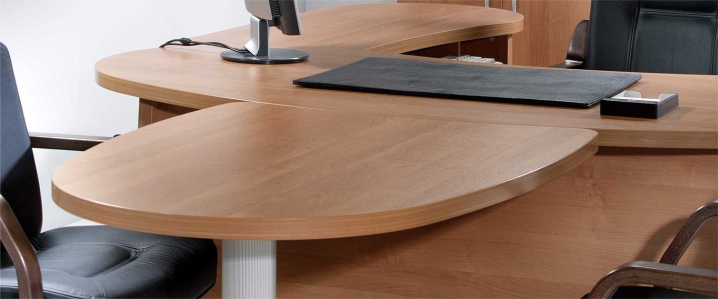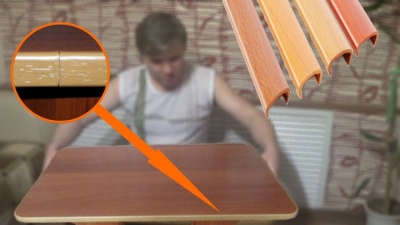Varieties and dimensions of edges for laminated chipboard

Laminated particle board edges - a demanded type of facing material necessary for the refinement of furniture items. There are many types of these products, which have their own characteristics, properties and shape. To select the parts you need, you need to understand their characteristics.


What it is?
Furniture edge is a plate, the dimensions of which coincide with the dimensions of MDF and laminated chipboard. They serve for the edge finishing of different materials, differ in texture and color. Basically, such strips are used for facing the end face of chipboard and other plates.
The usual form of material release is ribbonbut there are edges in the form of overhead profiles with different widths and thicknesses.
When facing cuts, the most important thing is to carefully choose the format of the product.


What are they needed for?
Edging of raw edges in the manufacture of furniture parts - an indispensable condition for an aesthetically pleasing appearance of the entire structure, in addition, a well-chosen edge protects the wood from moisture penetration into its structure. If the solid wood has a higher moisture resistance, then this cannot be said about laminated chipboard. Without this finish, they look very unsightly.
Based on the properties of chipboards, facing products intended for their preservation and beauty are endowed with such functions as:
- masking the wood structure, making furniture more attractive and refined;
- protection of cuts of furniture material from UV rays, moisture and temperature extremes;
- also, these details are an obstacle for the undesirable release of specific substances - formaldehydes, which are part of the semi-liquid base of the panels.
Due to the fixing of parts on wooden plates, the protected edges of furniture products are not subject to rapid wear, damage to them, the occurrence of scratches during careless use, and deformation due to high humidity are excluded.


Views
For the manufacture of furniture edges, various materials are used that are relevant for all kinds of furniture with different functionality.
- Common variant – painted PVC edging... This is an inexpensive solution for finishing cuts - this type of edge can be with glue, have a different texture or a smooth surface. Polyvinyl chloride has a number of advantages:
- sufficient strength;
- resistance to mechanical stress;
- invulnerability to moisture, low and high temperatures;
- variety of color palette;
- long service life.

- Plastic tape (ABS) is an environmentally friendly product. Such edging materials are made in several variations, they are matte and glossy. Moisture resistant thermal plastic can be used for bathroom and kitchen furniture.


- Rarely used veneer tape (natural wood) beautiful, but prone to cracking and not flexible enough.


- Made of thick single-ply or multi-ply paper impregnated with melamine, it is produced melamine edging. This is a plastic end finish that can take the desired shape. However, the material is not resistant to moisture and is vulnerable to mechanical stress. As a rule, the top of the tape must be varnished to increase its service life.

- For edge cladding can be used U-shaped or T-shaped overhead profile with a rigid structure, put on directly on the cut.This is a good protection for furniture boards thanks to the fixation on liquid nails. But dirt can accumulate in the profile protrusions, and this is a significant drawback of such edges.


- Metallized products, in addition to protection, provide a spectacular look to furniture. Popular options are chrome, bronze, aluminum, steel mirror tape. Also, mirror parts can be made of PVC and ABS.

One cannot fail to mention such an original finishing material as a two-layer laser edge obtained by extrusion from two types of plastic. It has high strength and excellent decorative appearance.
Dimensions (edit)
When choosing edging for furniture, it is important to take into account the size of the products - this will allow the interior items to look as natural as possible. Parts made of different materials have certain parameters.
- The usual width of PVC products is 26.5 mm, but wider tape from 150 to 300 mm is also found. Their thickness is 0.4, 1 and 2 mm.
- The width of the ABS plastic edge is 19-22 mm. The thickness of the finish is from 0.4 to 2 mm, but the most reliable protection is provided by a thick tape 3 mm thick.
- Overhead U-shaped profiles are available in sizes 16x3 mm and 18x3 mm.
It is worth measuring for different items and pieces of furniture before edging thickness... If chipboard boards are used - 16 mm, and when it is necessary to finish the worktop - 32 mm.

Selection and use
When choosing edges, you should adhere to the basic requirements for them:
- pay attention to the compatibility of the edging material and furniture;
- for self-finishing, it is better to choose parts with an adhesive base;
- the type of fixation (mortise, laid on or rigid) is selected based on the purpose of the edge;
- the texture, color and finish of the products must match the characteristics of the furniture and improve its appearance.
It is always important to choose the exact size of the edge - its width should cover the edges of the cut completely. You can calculate the thickness based on the operating conditions of the furniture and its purpose.

Various types of edging are used for finishing MDF, chipboard and laminated chipboard, but are also widely used for decorating cabinets, chests of drawers, headsets and walls, furniture lamps and do-it-yourself cabinet furniture.
Choose only high-quality, durable and suitable for the interior types of cladding that can reliably protect the furniture and last as long as possible.
For information on how to properly glue the furniture edge yourself, see the next video.













The comment was sent successfully.